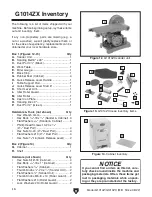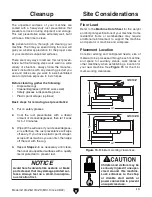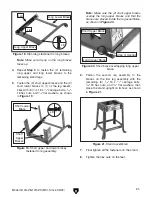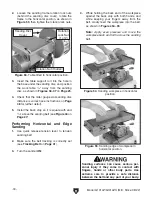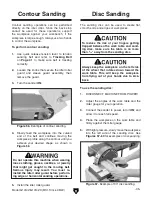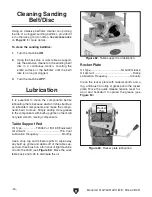
-32-
Model G1014Z/G1014ZX (Mfd. Since 08/22)
Sanding Tips
•
Extend the life of the sandpaper by regularly
using PRO-STIK® abrasive belt cleaners
(see
Accessories on Page 42).
•
When sanding workpieces with a bow or
crown, place the high point up on the able
to prevent the workpiece from rocking, then
take very light passes.
•
Hold workpiece securely with both hands and
do not wear gloves. Use work table, miter
gauge, and back stop whenever possible to
support workpiece. Do not force workpiece
against belt or disc.
•
Sanding discs/belts clog and wear. Change
sandpaper whenever you notice a difference
in sanding quality/performance.
•
To increase the life of the sanding disc/belt
and ensure even wear, move the workpiece
back and forth across the sanding surface.
•
As a rule-of-thumb, sand with progressively
higher grit numbers. A higher grit will achieve
a finer finish.
•
Make sure sanding belt and V-belt covers are
closed and secured during operation.
•
Avoid sanding a workpiece more than is
necessary, since doing so will unnecessarily
decrease belt life and cost you more money
over time.
A moving belt or disc can cause serious
personal injury if it comes in contact with
your fingers, hands, or other body parts.
Always support the workpiece against
the table, back stop, or miter gauge when
sanding. Use extreme care to provide a safe
distance between sanding paper and any
body part.
Choosing Sandpaper
The Model G1014Z/G1014ZX uses a 6" x 48"
sanding belt and a 9" sanding disc. Below is a
chart that groups abrasives into different classes,
and shows which grits fall into each class.
Grit
Class
Usage
36
Extra Coarse Rough sawn boards,
thickness sanding,
and glue removal.
60
Coarse
Thickness sanding
and glue removal.
80–100
Medium
Removing marks and
initial finish sanding.
120–180 Fine
Finish sanding.
We recommend using aluminum-oxide sand-
ing belts and discs for best results. The grit
you choose will depend on the condition and spe-
cies of wood, and the level of finish you wish to
achieve.
The general rule of thumb is to sand a workpiece
with progressively higher grit numbers. Avoid
skipping grits; the larger the grit increase at one
time, the harder it will be to remove the scratches
from the previous grit.
Ultimately, the type of wood you use and your
stage of finish will determine the best grit types to
install on your sander.
Note: Sandpaper finer than 180-grit will easily
load up or burn workpieces.

